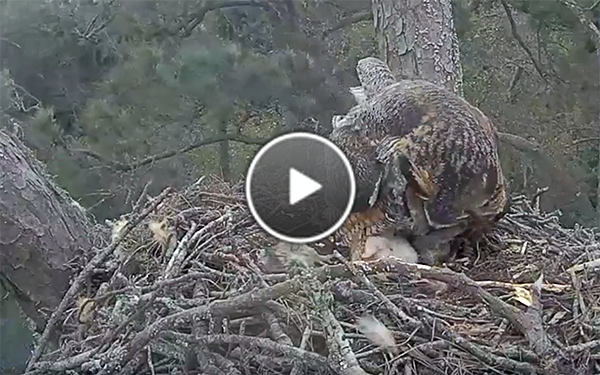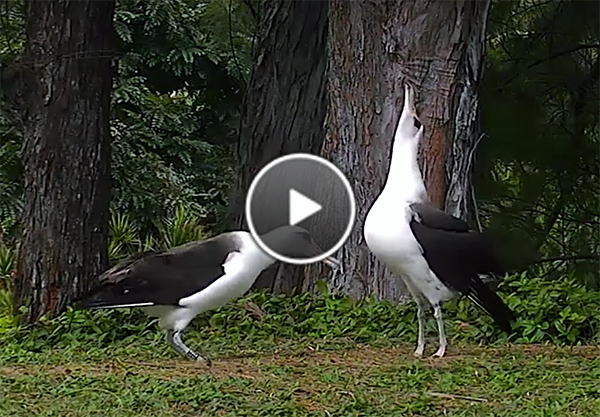 |
| A rare morning glimpse of the newly hatched owlet on cam 2. |
|
Owl Eggs Are Hatching in Savannah!
It has been 33 days since the first egg was laid in Savannah, Georgia, and early this morning viewers were greeted with the sight of a downy white owlet nestled against the second pipped egg. These last few weeks of incubation have given us stunning closeups of the female’s nictitating membranes (think “goggles for owls”) and extreme gentleness around the eggs. But now, the real work of raising the owlets begins, and you’ve got the chance to watch the second owlet hatch live.
The mother owl will begin feeding the nestlings food gathered from the surrounding forests and salt marsh. Much of this food will be brought to the nest by her mate or exchanged with the female off camera. Last year’s first meal of Clapper Rail took everyone by surprise, and the owls proved very opportunistic in their prey gathering throughout the season. The young owlets will only stick around the nest for 6-7 weeks before branching out into the surrounding world—don’t miss a minute of the action! Watch the cam, hosted by Skidaway Audubon. |
|
 |
| Watch two walkers practice their courtship skills on camera. |
|
An Albatross Celebration of Life
The bustling community around our #AlbatrossCam continues to open our eyes to the complex rituals of these majestic birds. Our two nestlings in view, Honua and Kialoa, are now left to explore the site on their own as both sets of parents make the long voyage out to sea for the squid that fuel the youngsters’ growth. They have been returning every few days to feed the young birds, sometimes multiple meals a day, and spending time near the chicks.
In addition to breeding activity, the cam site has been visited multiple times by “walkers,” or adults that are not breeding at this site this year. These walkers will hang out with the young nestlings and court with other walkers, often under the watchful eyes of Honua and Kialoa, and sometimes in groups of 3 or 4 adults. In the coming weeks we expect to see a third nestling emerge from a downhill nest site to join the fray. |
|
 |
| Ezra and Big Red have been busy getting ready for spring. |
|
Cornell Hawks: Which Nest Will It Be?
Over the last couple weeks, Big Red and Ezra have been putting on an exhibition for local birders-on-the-ground. Twigs have been brought to both of the nests that they have previously used during 2012-2015 (watch highlight), and it’s anyone’s guess which site will be their final choice. If they keep to the same schedule as in past years, we can expect them to settle in and start laying eggs in mid-March, so there’s still a few weeks for them to choose. We’ll continue posting updates on the Cornell Hawks Twitter feed and on our Bird Cams Facebook page—stay tuned! |
|
|
|